‘Avatar: The Way of Water’: How James Cameron Built His Ambitious Epic to Please an Eager Audience
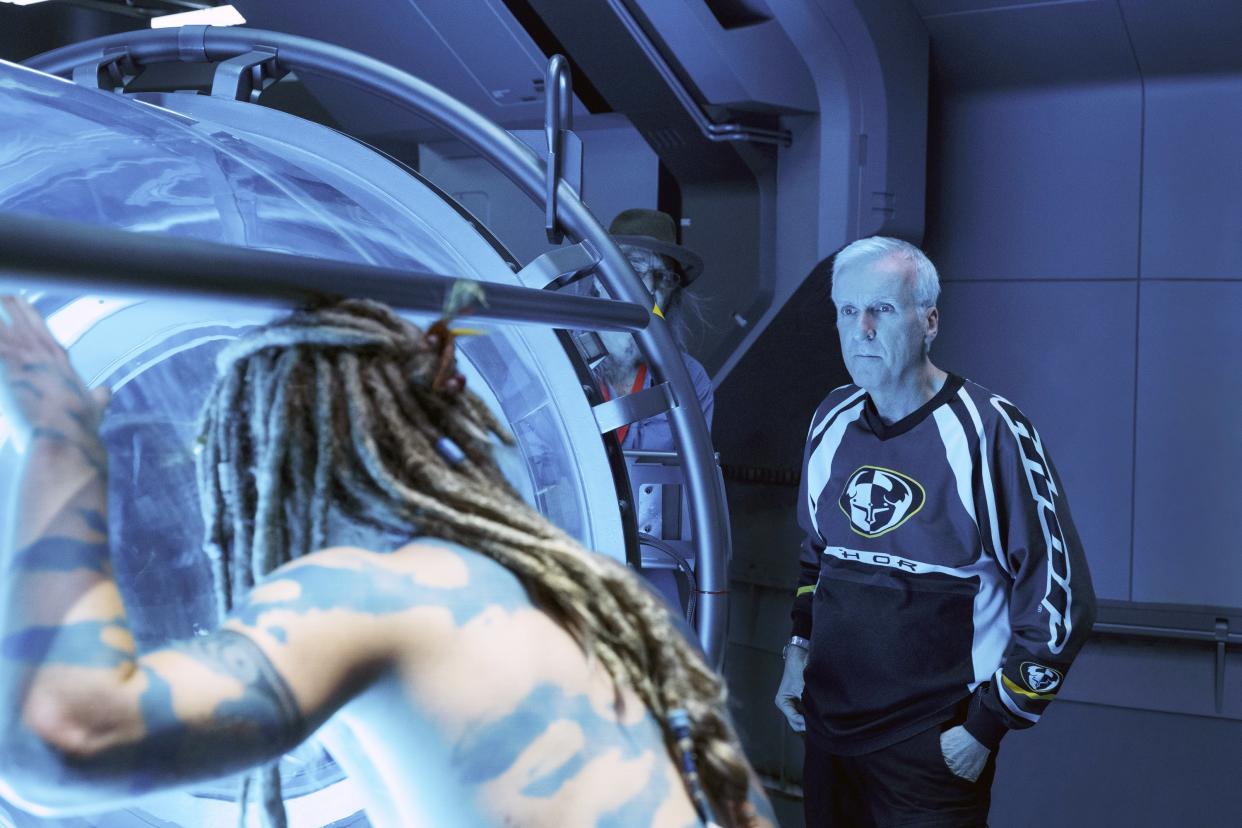
- Oops!Something went wrong.Please try again later.
- Oops!Something went wrong.Please try again later.
[Editor’s note: The following story contains some spoilers for “Avatar: The Way of Water.”]
James Cameron is a consistent over-achiever. He works overtime to create movies that make audiences happy. He tries to stimulate their pleasure center. And he wants to lure them back for repeat viewings.
More from IndieWire
It's a Not-So-Jolly Christmas as Box Office Plummets Due to Weather and (Mostly) Weak Films
'Poor Tom': Kate Winslet Feels Bad for Tom Cruise After Breaking His Underwater Record
Released 13 years after the original, Cameron’s “Avatar” sequel, “The Way of Water,” cost so much ($350-400 million) that the filmmaker estimates it has to gross $2 billion to make a profit. (It’s among the most expensive films ever made.) But that’s why Cameron cares so much about crafting a four-quadrant movie that plays to the widest possible audience.
Just like “Titanic” 25 years ago — which stayed in theaters for a year and wound up grossing a global $2.202 billion over time — and the original “Avatar” — which grossed a mighty $2.9 billion worldwide — “The Way of Water” is accessible, sincerely romantic, and packed with action.
But even Cameron has to level up, and his “Avatar” and its sequel combine romance with 3D immersion into a sumptuously beautiful world that is under attack. In “The Way of Water,” Jake Sully (Sam Worthington) and Neyteri (Zoe Saldana) are forced to take their family away from their forest home because they are being targeted by the vengeful recombinant avatar of the late Colonel Miles Quaritch (Stephen Lang) and his RDA marines. The Sully family fly to a distant atoll to ask for sanctuary from the Metkayina, a clan that thrives underwater. Here they must adapt — and fight back when Quaritch tracks them down.
Opening weekend, the film got off to a strong, if not blockbuster start (Metascore: 69), grossing $434 million worldwide, including on 3D screens in China, which rarely books Hollywood movies but embraces Cameron’s love of IMAX 3D. Cameron’s movies tend to build over time: stateside Christmas shows are already selling out.
Here’s how Cameron crafted his populist masterwork, which should follow “Titanic” and “Avatar” into the Oscar race, from an inevitable VFX win to Best Picture and Director and multiple craft nominations. (We spoke on Zoom, as the director was on day two of his first bout of COVID, contracted on the last leg back to Los Angeles on his promo tour to England, France, Korea, and Tokyo.)
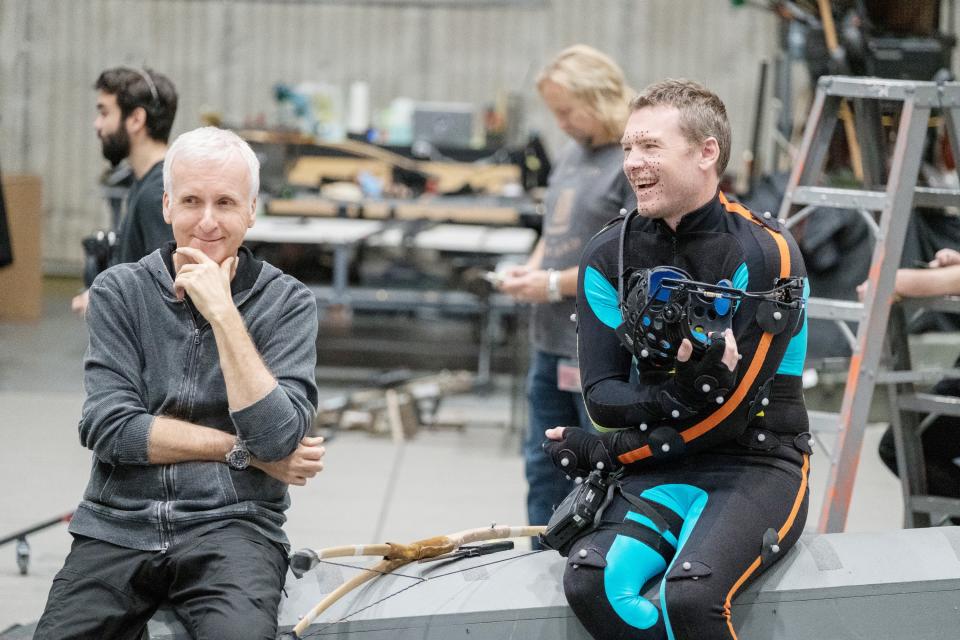
©Walt Disney Co./Courtesy Everett Collection
He took a “break” (straight into the Marina Trench).
After “Avatar,” Cameron was exhausted and needed to recharge his batteries. “I call it decompressing,” said his Lightstorm Entertainment producing partner Jon Landau. “We went through this cutting-edge pressure on Jim, a story with blue people that have tails that people called ‘Ferngully’ at some point. It was a five-year journey.”
Cameron’s idea of fun was taking two years to help to design a special submersible in Australia, Deepsea Challenger, that could take him and his 3D camera 35,787 feet below the ocean surface to the bottom of the deepest spot in the ocean, the Mariana Trench, on March 26, 2012. It took two hours and 37 minutes to get there. Cameron regards all his underwater explorations as research for “Avatar: The Way of Water.” “I’m all about the prep,” he said.
He and Landau also produced several documentaries, as well as the long-planned graphic novel adaptation “Alita: Battle Angel” (2019), written by Cameron and directed by Robert Rodriguez, which provided valuable research and development for the “Avatar” sequel.
He started writing three “Avatar” sequels — with help.
Cameron didn’t want to get caught (again) investing in a movie like “Alita: Battle Angel” and its sequel, only to have that sequel never get made. He threw out the first “Avatar 2” script, which was not about the fate of the Na’vi. (It’s coming out as a comic book.) His experience on his only TV series, “Dark Angel,” gave him the idea of creating another writers room to figure out an extended “Avatar” story over three films based on some 1,500 pages of notes it took a year to write.
Cameron partnered with the writing team of Amanda Silver and Rick Jaffa (“The Planet of the Apes”) as well as Josh Friedman (“Terminator: The Sarah Connor Chronicles”) and Shane Salerno (“Armageddon”). The team wrote for four years before production began in 2017. “I like that idea of having this group of creative people all playing in the same sandbox,” the director said. “And then everybody goes off and writes their draft.”
He figured he’d partner with the writers on each film. “I’m common to all them,” he said. “And that way I can make it all consistent stylistically. So we just sat in a room for six months with whiteboards and we wrote it all out. On the very last day of that process, I gave them their individual films. Because I knew that if I did it right up at the beginning, they’d just check out when we were talking about the other movie. I wanted the benefit of their creativity equally across all three films. So they went off and wrote, and then turned the scripts in.”
But the first script for “Avatar 2” “was all too smashed in,” he said. “So I split it into two and rewrote it myself into two movies. So movie two and three as they are now were originally just movie two.”
“He expanded it, ” said Landau. “He took a little from here and a little from there and created a whole new story. He wanted to make sure each story came to its own conclusion and emotional resolution. In each sequel, we meet new clans, go to new biomes. But we continue the stories of the characters we’ve met.”
Cameron the writer puts himself in all his characters.
Worthington’s Jake Sully is a military leader who throws his weight around in the family — and gets pushback from his kids. Cameron identifies with Jake “to some extent,” he said. “But I mean, I’m also Kiri. And I’m also Lo-ak. I remember as a kid being the misunderstood artistic teenager of the autocratic engineer father. I don’t mean to put my dad down, he put a roof over our heads. He was great dad, in that regard, but he didn’t get me at all. No one was more mystified on the planet than him when I actually was able to make money at this stuff. But there was a bit of me in all the characters, I find it particularly easy to write Quaritch and Selfridge [Giovanni Ribisi], which bothers me. Every writer has aspects of their life that they work out in their characters.”
For Landau, the secret of Cameron’s success is clear: “Jim has never lost the 16-year-old kid inside of them who went to the movies and was enthralled by the potential of cinema. When we make our movies, we make them for audiences.”
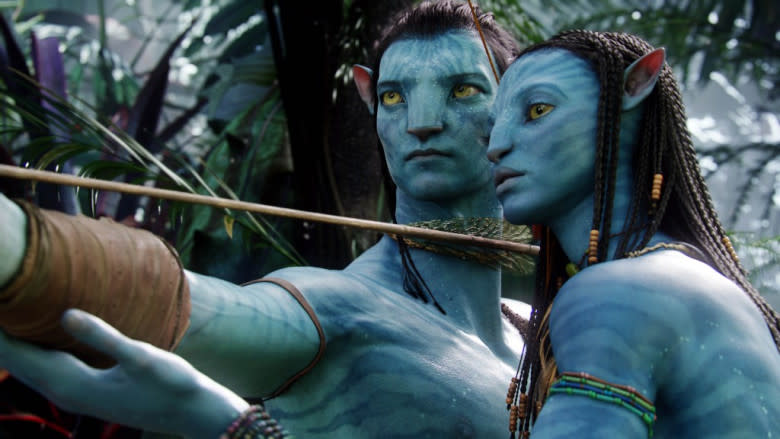
Disney
Capturing the magic of Pandora is key to moviegoers wanting to revisit the planet.
During post-production on the first “Avatar,” Cameron had to fight the Fox studio to keep the moments when Sully follows Neytiri through the forest, marveling at the fauna and flora and floating sprites.
“It was much to the studio’s surprise that in our test screenings, we found out that the two most-liked scenes in the film were the two things they kept trying to get me to cut out,” said Cameron. “One was the traipsing around the forest at night in the bioluminescence and touching things and having it react and the wood sprites flying around.”
The other one? “The flying scenes where Jake and a Neyteri are falling in love,” Cameron said. “Their argument was it doesn’t advance the plot, and the movies were too long. I said, ‘Guys, this is what people are going to like the most.’ Of course, that’s what proved to be the case, because that was the transporting or epiphany or beautiful aspect of it. That was wish fulfillment.”
This time, he found those transporting moments underwater.
“The kind of phantasmagorical night forest in the first movie,” said Cameron, “we didn’t do it again in this film, because it was a grimmer suspense scene where the kids have been captured, when we’re in the night forest. We played it rainy, and we played down the bioluminescence a little bit, it’s still there. But we didn’t want it to be so beautiful. We save that for when you get to the reef, and you’re introduced into the new world of that film.”
Cameron’s actors learned to hold their breath underwater, wearing performance capture gear as they entered, swam, and exited the water. (Kate Winslet chose to break Tom Cruise’s record with a seven minute, 15 second hold.) “There’s very little true photography in the film,” said Cameron. “So anytime we’re on one of the live-action characters like Spider, Jack Champion’s character, or the guy that’s the tulkun hunter, obviously that’s photography, and we use a lot of conventional techniques like blue screen and so on to extend sets and incorporate the CG [computer graphic] characters into it. But the other 80 percent of the movie is all meant to look like photography — it’s 100 percent rendered. That’s the challenging part, to get the nuances of performance and the little light in the eye of the people and every little bit of neck movement and neck tendon and the delicacy of the hands is a tribute to the pipeline that we created.”
But the actors also had to emote underwater. “That was the most challenging from an acting standpoint,” said Landau. “As well as scenes where you have intimate human-CG interaction.”
While Wētā FX worked on rendering the actors, their artists were also creating the underwater world in the computer. “The challenge that came subsequently was how to render water seamlessly,” said Cameron. “What we found was that there wasn’t a magic wand technical solution. It turned out to be very artist-sensitive, meaning the individual artists working with the tools had to learn the way of water, it became this Zen archery thing. They had to learn how water worked on an elevated level. … People take water utterly for granted, so we actually don’t get any particular love from the audience for doing that which they expect to be there photographically. It took us years and tens of millions of dollars to get to zero, so that we could then tell our story. But it’s all worth it.”
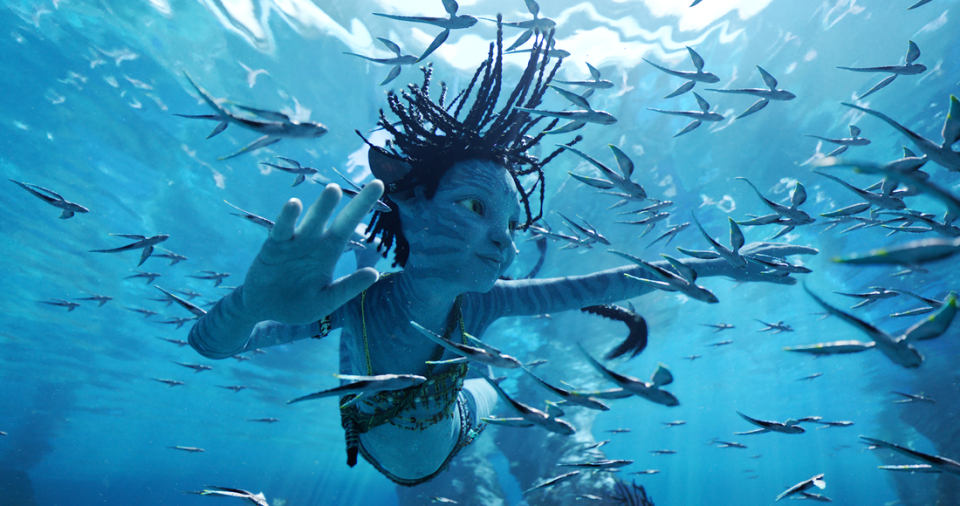
Courtesy of 20th Century Studios
“The Way of Water” reveals what performance capture can do for actors.
As far as Cameron is concerned, the enhanced high-definition facial rigs (two this time, instead of one) and the sophisticated algorithms at four-time Oscar-winner Joe Letteri’s Wētā FX are capturing and rendering actors’ performances. “Actors who don’t understand that are always saying, ‘Oh, you’re trying to replace the actor.’ No, I’m trying to replace prosthetic makeup that’s very hard to act through, hard to get nuances through when they’re gluing rubber all over your face,” he said. “This is a way to be a character that’s humanoid, acceptable. But there’s no rubber and we’ll capture every molecule of what you’re putting out there. You have to remind [the actors] in advance not to overact.”
There are more characters in this film than any other he has made, said Landau. “Our biggest advancement was the close-up. How did we put more characters up on the screen who are even more emotive and engaging than the first film? We needed to be more photographic,” the producer said. “When you have Kiri, a character we are realizing with CG effects, hugging [human, live-action] Spider, on the screen at the same time, she has to be as real as he is.”
Cameron also demonstrates another capability for performance capture, as Sigourney Weaver charmingly plays Kiri, the fifteen-year-old daughter of Weaver’s character from the first film, Grace. “I wanted to do something that connected the dots around Grace’s relationship with Eywa [Pandora’s all-mother goddess] and her avatar,” he said, “but I couldn’t bring human Grace back, she was dead. So I thought, ‘Let’s create this daughter that has some kind of divine purpose. Right? From essentially Grace’s avatar.’ Basically Sigourney comes back and plays her own daughter.”
He wants actors to take note. “How about the possibility that you could play any age, you could play any gender, you could play any race, really? So Sigourney at 69 coming back and playing a character a quarter of her biological age?,” Cameron said. “I’m thinking that might get noticed by actresses of a certain age.”
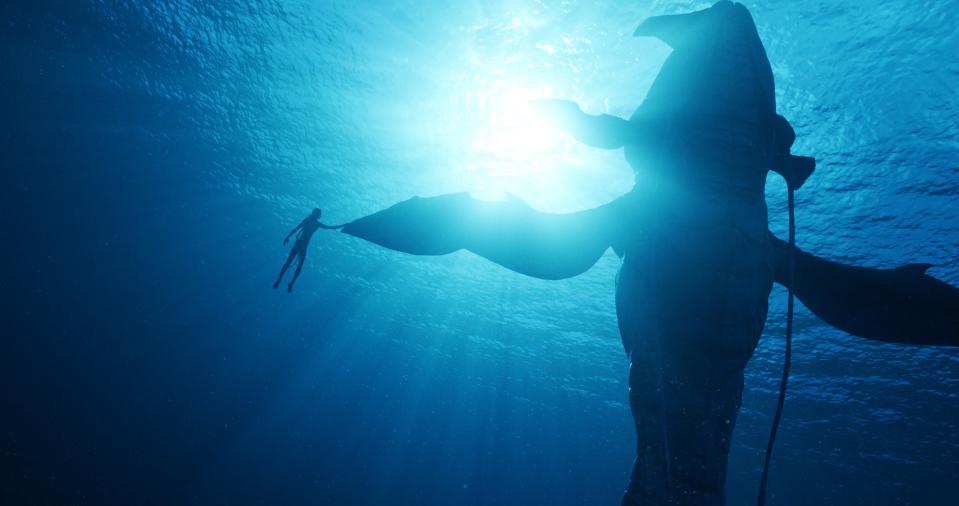
Courtesy of 20th Century Studios
“The Way of Water” balances the beauty and the violence.
People forget that after “Terminator,” Cameron wrote “Rambo: First Blood Part II.” One of his great skills is knowing how to establish characters and their vehicles and weapons. In “The Way of Water,” he channels his inner Rambo as he has a fine time blowing shit up.
“I cannot deny it,” he said. “But actually there was more gunplay in the original cut of the film, more machine guns, more brutality. And I had this epiphany about six weeks before I locked picture. I woke up from a nightmare. And I thought, ‘I don’t have the balance between the beauty and the attraction, the epiphany parts of the movie, and the brutality.’ I didn’t have so much a problem with the human soldiers, I had more of a problem with Jake, because he’s our character that we’re following. … I cut a lot of stuff out that was mostly gun-oriented.”
Cameron celebrates strong women (per usual).
From Sigourney Weaver as Ripley in “Aliens” through Linda Hamilton as Sarah Connor in the “Terminator” series, Cameron has always placed strong women at the center of his movies — even when that wasn’t acceptable in the culture — and got away with it. One reason: they were protecting children.
“I didn’t have a problem with Neyteri slaughtering everybody left and right with her bow,” he said. “I wanted to challenge the audience to still love her. She gets pretty far out on a limb, that maternal instinct thing gets triggered. We did find a lot of love from older females of the four quadrant demographic analysis, because typically that’s the part of the audience that doesn’t really hang with the action and the violence and the science fiction of it all. But they actually really quite like the film, and it was because of that maternal instinct getting triggered by her character.”
Another strong woman is Ronal, the matriarch of the Metkayina clan played by Winslet, who signals with a silent look to her husband (Cliff Curtis) that the Sully family can stay. She has a larger role in “Avatar 3” — and goes into battle while pregnant. “We’re just laying a foundation in ‘The Way of Water,'” said Cameron. “I wanted to be really upfront that [movie] three’s in the can, [movie] four is partially in the can, there’s a lot of momentum on this thing, because there’s clearly things that are unresolved.”
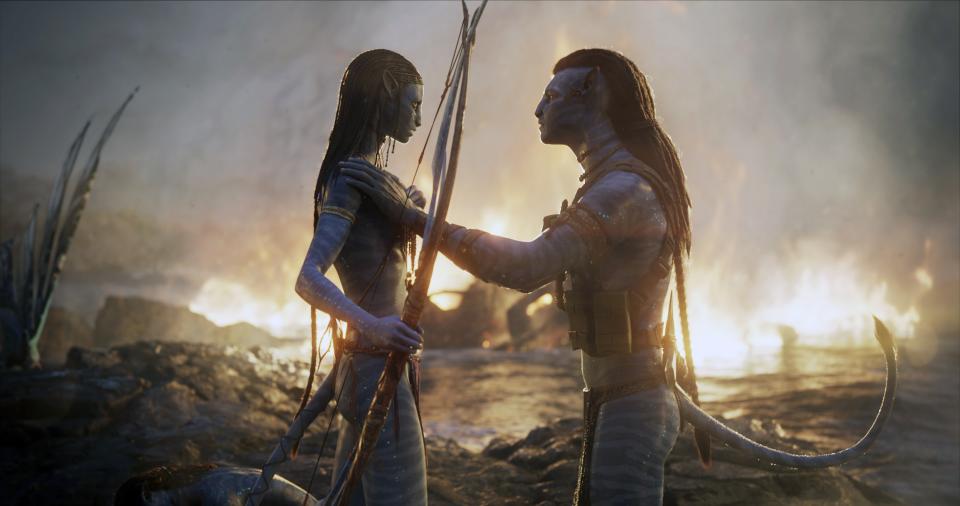
©Walt Disney Co./Courtesy Everett Collection
3D is only as good as you can make it.
The reason Cameron deployed the much-decried 48 frames per second frame rate on “The Way of Water” was to make the 3D better. “I don’t see it as a format,” he said. “You don’t want to just do the whole movie in it, but it can definitely help with the authoring in the 3D. We pride ourselves on our 3D, we want to give people a good experience.”
He added, “My motto is it always has to add value. If it’s ever taking away value, then you shouldn’t do it. Sometimes in 3D, our brains become hyper-aware of vertical lines moving laterally, right? If we do those scenes at 48 frames, they look smooth. It’s pretty much that simple.”
Cameron previews his movies for audience reaction.
The filmmaker always likes to see how his movies play. This time around, for security reasons, he had to recruit the research previews with Disney friends and family. “You’ll learn interesting things,” he said. “They’ll tell you what’s working and what’s not working. Good. And one of the big surprises was Payakon is their favorite character in the movie.”
“The Way of Water” creates a whale-like animal, the solo tulkun befriended by Lo’ak, who pulls us into identifying with him as a non-human sentient being. “It’s really the duet of Lo’ak and Payakon,” said Cameron, as Britain Dalton acted opposite Kevin Dorman, seated behind a screen covered with a piece of red tape where Payakon’s red eye would be. “He would create these sympathetic expressions, and he would create these vocalizations, not the final vocalizations in the movie, but he just would make what he imagined Payakon would sound like.”
Thus we are invested in Pandora and Payakon when Quaritch and his recombinant marines join a tulkun-hunting expedition en route to destroying the Sully family.
“Payakan becomes representative of the natural world of purity, and the victim of human expansion, but also he represents the sentient whales that we have right here for real on planet Earth,” said Cameron, who won an Emmy for National Geographic’s four-part series “The Secrets of Whales.” “It’s about the culture that whales have that they hand down to their children. They’re much more sophisticated than we thought they were. If we can make that case, then that’s an added bonus to going on an adventure and having all this beautiful eye candy.”
There’s enough juice in the Cameron tank for more than “Avatar.”
Cameron has options going forward. He doesn’t have to direct all the succeeding “Avatars.” He can do more TV. “I could,” he said. “Hopefully we’ve got our process efficient enough that I’ve got a little spare RAM for some side hustles like producing some other stuff that I don’t direct. And I love writing.”
“Avatar: The Way of Water” is now in theaters.
Best of IndieWire
Sign up for Indiewire's Newsletter. For the latest news, follow us on Facebook, Twitter, and Instagram.

